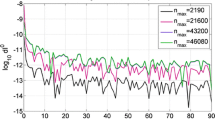Abstract
The computation of spherical harmonic series in very high resolution is known to be delicate in terms of performance and numerical stability. A major problem is to keep results inside a numerical range of the used data type during calculations as under-/overflow arises. Extended data types are currently not desirable since the arithmetic complexity will grow exponentially with higher resolution levels. If the associated Legendre functions are computed in the spectral domain, then regular grid transformations can be applied to be highly efficient and convenient for derived quantities as well. In this article, we compare three recursive computations of the associated Legendre functions as trigonometric series, thereby ensuring a defined numerical range for each constituent wave number, separately. The results to a high degree and order show the numerical strength of the proposed method. First, the evaluation of Fourier coefficients of the associated Legendre functions has been done with respect to the floating-point precision requirements. Secondly, the numerical accuracy in the cases of standard double and long double precision arithmetic is demonstrated. Following Bessel’s inequality the obtained accuracy estimates of the Fourier coefficients are directly transferable to the associated Legendre functions themselves and to derived functionals as well. Therefore, they can provide an essential insight to modern geodetic applications that depend on efficient spherical harmonic analysis and synthesis beyond [\(5~\times ~5\)] arcmin resolution.







Similar content being viewed by others
References
Cheong HB, Park JR, Kang HG (2012) Fourier-series representation and projection of spherical harmonic functions. J Geod 86:975–990
Claessens SJ (2005) New relations among associated legendre functions and spherical harmonics. J Geod 79:398–406
Dilts G (1985) Computation of spherical harmonic expansion coefficients via FFT’s. J Comput Phys 57:439–453
Elovitz M (1989) A test of a modified algorithm for computing spherical harmonic coefficients using an FFT. J Comput Phys 80:506–511
Fukushima T (2012) Numerical computation of spherical harmonics of arbitrary degree and order by extending exponent of floating point numbers. J Geod 86:271–285
Gruber C (2011) A study on the Fourier composition of the associated Legendre functions; suitable for applications in ultra-high resolution, (Scientific Techncial Report STR; 11/04). Deutsches GeoForschungsZentrum (GFZ)
Gruber C, Novák P, Sebera J (2011) FFT-based high-performance spherical harmonic transformation. Stud Geophys Geod 55:489–500
Heiskanen WA, Moritz H (1967) Physical & geodesy. W.H. Freeman Company, San Francisco
Hobson EW (1955) The theory of spherical and ellipsoidal harmonics. Chelsea Publishing Company, New York
Hofsommer DJ, Potters ML (1960) Table of fourier coefficients of associated legendre functions, report R 478. KNAW, Computational Department of the Mathematical Centre, Amsterdam
Holmes SA, Featherstone WE (2002) A unified approach to the clenshaw summation and the recursive computation of very high degree and order normalised associated legendre functions. J Geod 76:279–299
Jekeli C, Lee JK, Kwon JH (2008) On the computation and approximation of ultra-high-degree spherical harmonic series. J Geod 81:603–615
Kaula WM (1966) Theory of satellite geodesy. Blaisdell Pub. Co., Waltham
Koop R, Stelpstra D (1989) On the computation of the gravitational potential and its first and second order derivatives. Manuscripta Geodaetica 14:373–382
Sneeuw N, Bun R (1996) Global spherical harmonic computation by two-dimensional fourier methods. J Geod 70:224–232
Sansone G (1959) Orthogonal functions. Reprint: Dover Publications Inc, 31 East 2nd Street, Mineola, NY11501. Orig. published: Interscience (pure and applied mathematics: vol. 9)
Wagner CA (1983) Direct determination of gravitational harmonics from low–low GRAVSAT Data. J Geophys Res 88(B12):309–321
Acknowledgments
The authors have obtained valuable hints from Prof. Nico Sneeuw, Universität Stuttgart that have helped to improve the manuscript substantially. The software comparison was conducted with minor modifications concerning under-/overflow to software written by Nico Sneeuw at IAPG, TU-Munich 1994.
Author information
Authors and Affiliations
Corresponding author
Appendices
Appendix 1
To demonstrate how the Fourier coefficient round-off errors will infiltrate the functional domain, we consider Bessel’s inequality. Following Sansone (1991), we can use the theorem:
“Let {\(f_k\)} be a sequence of orthonormal functions in \(\sigma \), F square integrable in \(\sigma \) and {\(a_{k}\)} the sequence of Fourier coefficients with respect to {\(f_k\)},
then the series
is convergent, and, moreover, the \(a_k\) will satisfy Bessel’s inequality:
Concerning the round-off errors \(\epsilon \) of our coefficients, we put:
and for the square residuals of the finite series
Note that \(\sigma \in [0;2\pi ],\) although the Legendre functions \(P_{lm}\) are known to be square integrable (i.e., they form another orthonormal system) only in \([0; \pi ]\). However, we need only a well-defined subset of the sequence of orthonormal functions \(f_k' \subset f_k\), where the Fourier integrals may be used to obtain the appropriate coefficients \(a_{lmk}\). These are (Eq. 1):
In all other cases, \(\int \limits _0^{2\pi } P_{lm}~f_k~\mathrm{d}\sigma \) are not guaranteed to be solved correctly. We then continue for the subset \(f_k'\) and obtain
where
Because the error-free solution is defined by
we obtain for the square residuals
which corresponds to what we have been investigating throughout Eqs. (24–27) and also in Eq. (28) and can thus be considered as corresponding deviation in the functional domain.
Appendix 2
The dynamical scaling works as follows: the sectorial Legendre function \((l=m)\) serves as starting value and is subject to numerical underflow such that extended exponent values have to be stored. In the course of the recursive computations of the respective degrees, the external exponents are then partially re-applied before overflow values occur until the scales have fully dissolved.
During l-recursion, the Legendre functions are then re-scaled in the following way:
Rights and permissions
About this article
Cite this article
Gruber, C., Abrykosov, O. On computation and use of Fourier coefficients for associated Legendre functions. J Geod 90, 525–535 (2016). https://doi.org/10.1007/s00190-016-0891-z
Received:
Accepted:
Published:
Issue Date:
DOI: https://doi.org/10.1007/s00190-016-0891-z




